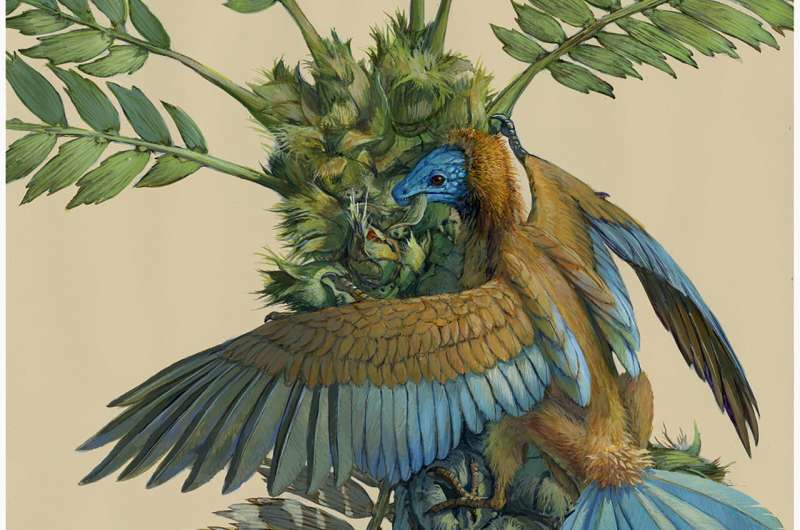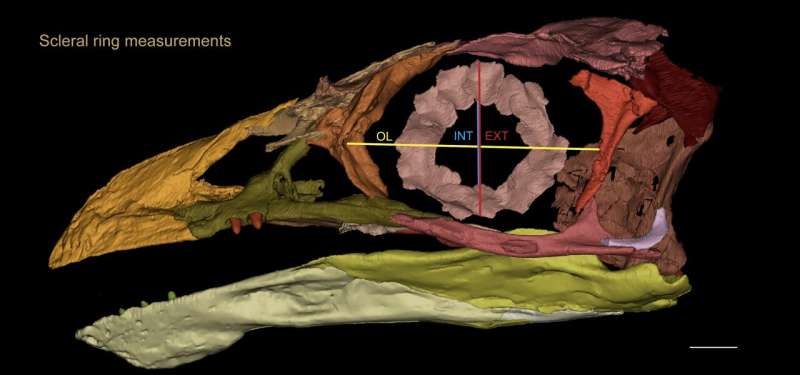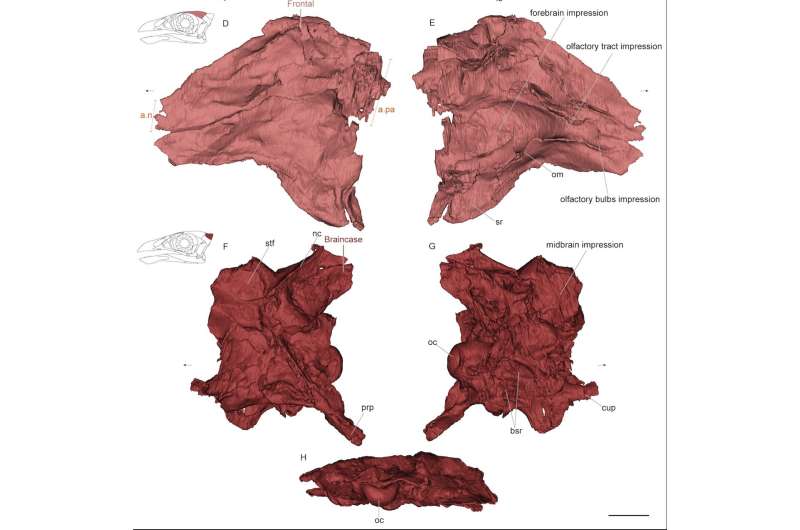Fossil bird's skull reconstruction reveals a brain made for smelling and eyes made for daylight

Jeholornis was a raven-sized bird that lived 120 million years ago, among the earliest examples of dinosaurs evolving into birds, in what's now China. The fossils that have been found are finely preserved but smashed flat, the result of layers of sediment being deposited over the years. That means that no one's been able to get a good look at Jeholornis's head. But in a new study, researchers digitally reconstructed a Jeholornis skull, revealing details about its eyes and brain that shed light on its vision and sense of smell.
"Jeholornis is my favorite Cretaceous bird, it has a lot of unusual, primitive traits, and it helps shed light on the bigger story of how different birds evolved," says Jingmai O'Connor, associate curator of fossil reptiles at the Field Museum and one of the authors of the paper describing the discovery in the Zoological Journal of the Linnean Society. "This study is the first time we're really getting at what this bird's skull looked like, what its brain must have been like, which is really exciting."
The study's first author, Han Hu, went through roughly 100 fossils at China's Shandong Tianyu Museum of Nature and selected the one with the best-preserved skull—still a little flattened, but intact. "It is very difficult to find the right skull among around 100 fossils, since we won't know if one skull will provide us the information we want before the scanning, and due to the costs of high quality scanning, we couldn't scan all those specimens to choose the best one. However, I chose this one because at least from the exposed surface, it is relatively complete, and which is also important is that this skull is preserved to be isolated from other parts of its body," says Hu, a researcher at the Department of Earth Sciences, University of Oxford, UK.
"This is very helpful since we usually won't chop the skull off from the skeleton if they are articulated—no one wants to hurt these previous fossils, but an isolated skull will reduce the size of the scanning area, which will increase the scanning quality a lot. Luckily, the specimen we chose here for this project is nearly a perfect one—it provided us so much unknown information after the digital reconstruction."
"These bones were kind of like the bottom of a bag of potato chips—they weren't completely crushed, but the pieces were compacted," says O'Connor. "So we were able to CT scan them—essentially taking a bunch of X-rays and stacking them together to form a 3D image—and then digitally re-articulate them and reconstruct the skull from all these bones."

"We were able to see different features of the skull that had never been seen before in Jeholornis, and we were even able to extrapolate what its brain looked like," says co-author and Field Museum postdoctoral researcher Matteo Fabbri.
The brain itself isn't preserved—soft tissues rarely are—but bird and dinosaur brains tend to nest neatly within their skulls. Knowing the shape and dimensions of a fossil bird's skull, therefore, tells us a lot about its brain, kind of like how a glove gives a decent approximation of how a hand is shaped. What's more, brain structures are conserved across species and over time—things like olfactory bulbs and the cerebellum in the same general spots whether you're looking at the brain of a frog, a human, or a fossil bird.
Thanks to the long-standing placements of these structures, the researchers were able to determine how Jeholornis's brain compares with modern birds and dinosaurs (or, strictly speaking, non-avian dinosaurs; all birds, including Jeholornis, are dinosaurs, but not all dinosaurs are birds).
"Jeholornis's brain morphology is transitional, in-between what we see in non-avian dinosaurs and what we see in modern birds," says Fabbri. "If you look at the skulls of dinosaurs, what you see is a spot for a very reptile-like brain, meaning that they have very large olfactory bulbs, and the optic lobes that are in the midbrain are reduced. They probably had a very good sense of smell and not great sight, which is very reptilian. And on the other hand, if you look at modern birds, they do the reverse. They have small olfactory bulbs, and very large optic lobes. Jeholornis falls in the middle."

Jeholornis had bigger olfactory bulbs than most modern birds, meaning that it probably relied more on its sense of smell than birds today (with the exception of a few keen-smellers, like vultures). Jeholornis's strong sense of smell makes sense in the context of another recent study by the team, showing that Jeholornis is the earliest-known fruit-eating animal. "As fruits ripen, they release lots of chemicals," says O'Connor. "We can't prove it yet, but having a better sense of smell might have helped Jeholornis find fruit."
In addition to a brain adapted for smelling, the researchers found that Jeholornis was likely better at seeing in the daytime than at night. Birds have bones called scleral rings that help determine how much light goes into their eyes. Species that need to see at night, like owls, have wider scleral ring openings relative to their eye sockets, to let in more light; birds that are active during the day have narrower openings for light to go through, like the aperture on a camera. Jeholornis's scleral rings seem to indicate that it was most active during the day.
All of these skull features provide a better understanding of this early bird's lifestyle and the role it played in its ecosystem. "Reconstructing a skull is painstaking work, and as people are starting to put in the time to do it, It's becoming more and more clear that the evolution of birds was more complicated than what we expected," says Fabbri. "It's not just different from dinosaurs and modern birds, it's different from other early birds too. It's not a straightforward evolutionary story."
"The same as Jingmai, Jeholornis is also one of my favorite birds. Its special position as one of the most primitive birds during the dinosaur-bird transition determines that completing its story will reveal the true scenery of that critical evolutionary period, and also, tell us why and how the modern birds—the only living dinosaurs—evolved to be what we see now," says HuThe early bird gets the fruit: Fossil provides earliest evidence of fruit-eating by any animal
More information: Han Hu et al, Cranial osteology and palaeobiology of the Early Cretaceous bird Jeholornis prima (Aves: Jeholornithiformes), Zoological Journal of the Linnean Society (2022). DOI: 10.1093/zoolinnean/zlac089
Journal information: Zoological Journal of the Linnean Society
Provided by Field Museum
No comments:
Post a Comment